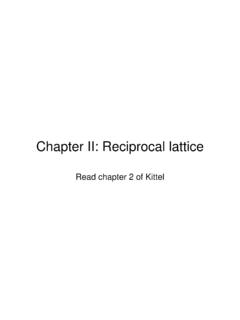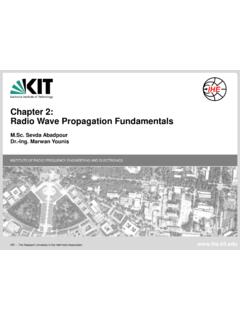Transcription of Chapter 14 Interference and Diffraction
1 Chapter 14 Interference and Diffraction Superposition of Young s Double-Slit Example : Double-Slit Intensity Example : Intensity of Three-Slit Single-Slit Example : Single-Slit Intensity of Single-Slit Intensity of Double-Slit Diffraction Diffraction Appendix: Computing the Total Electric Solved Double-Slit Phase Constructive Intensity in Double-Slit Second-Order Bright Intensity in Double-Slit Conceptual Additional Double-Slit Interference - Diffraction Three-Slit Intensity of Double-Slit Secondary Interference - Diffraction 14-1 Interference and Diffraction Superposition of Waves Consider a region in space where two or more waves pass through at the same time.
2 According to the superposition principle, the net displacement is simply given by the vector or the algebraic sum of the individual displacements. Interference is the combination of two or more waves to form a composite wave, based on such principle. The idea of the superposition principle is illustrated in Figure (a) (b) (c) (d) Figure Superposition of waves. (b) Constructive Interference , and (c) destructive Interference . Suppose we are given two waves, 11011122022( , )sin(), (,)sin()xtkxtxtkxt 2 +== + ( ) the resulting wave is simply 1011122220(,)sin()sin()xtkxtk xt += + + ( ) The Interference is constructive if the amplitude of (,)xt is greater than the individual ones (Figure ), and destructive if smaller (Figure ).
3 As an example, consider the superposition of the following two waves at : 0t= 12( )sin, ( )2 sin4xxxx == + ( ) The resultant wave is given by 14-2 ()12()()()sin2sin12sin2cos4xxxxxx x =+=++=++ ( ) where we have used sin()sincoscossin +=+ ( ) and sin(/ 4)cos(/ 4)2 / 2 ==. Further use of the identity []2222222222sincossincoscossinsincossin( )abaxbxabxxabababxxabx +=++ ++ =++=++ ( ) with 1tanba = ( ) then leads to ()522sin()xx =++ ( ) where 1tan(2 /(12 )) rad.
4 =+= = The superposition of the waves is depicted in Figure Figure Superposition of two sinusoidal waves. We see that the wave has a maximum amplitude when sin()1x +=, or / 2x = . The Interference there is constructive. On the other hand, destructive Interference occurs at radx = =, wheresin()0 =. 14-3 In order to form an Interference pattern, the incident light must satisfy two conditions: (i) The light sources must be coherent. This means that the plane waves from the sources must maintain a constant phase relation. For example, if two waves are completely out of phase with =, this phase difference must not change with time.
5 (ii) The light must be monochromatic. This means that the light consists of just one wavelength 2/k =. Light emitted from an incandescent lightbulb is incoherent because the light consists o waves of different wavelengths and they do not maintain a constant phase relationship. Thus, no Interference pattern is observed. Figure Incoherent light source Young s Double-Slit Experiment In 1801 Thomas Young carried out an experiment in which the wave nature of light was demonstrated. The schematic diagram of the double-slit experiment is shown in Figure Figure Young s double-slit experiment.
6 A monochromatic light source is incident on the first screen which contains a slit . The emerging light then arrives at the second screen which has two parallel slits S0S1 and S2. which serve as the sources of coherent light. The light waves emerging from the two slits then interfere and form an Interference pattern on the viewing screen. The bright bands (fringes) correspond to Interference maxima, and the dark band Interference minima. 14-4 Figure shows the ways in which the waves could combine to interfere constructively or destructively. Figure Constructive Interference (a) at P, and (b) at P1.
7 (c) Destructive Interference at P2. The geometry of the double-slit Interference is shown in the Figure Figure Double-slit experiment Consider light that falls on the screen at a point P a distance from the point O that lies on the screen a perpendicular distance L from the double-slit system. The two slits are separated by a distance d. The light from slit 2 will travel an extra distance y21rr = to the point P than the light from slit 1. This extra distance is called the path difference. From Figure , we have, using the law of cosines, 222221cossin222ddrrdrrdr =+ =+ ( ) and 222222cossin222ddrrdrrdr =+ + =++ ( ) Subtracting Eq.
8 ( ) from Eq. ( ) yields 14-5 22212121()()2sinrrrrrrdr =+ = ( ) In the limit L, , the distance to the screen is much greater than the distance between the slits, the sum of and may be approximated by d 1r2r122rrr+ , and the path difference becomes 21sinrrd = ( ) In this limit, the two rays and are essentially treated as being parallel (see Figure ). 1r2r Figure Path difference between the two rays, assuming . Ld Whether the two waves are in phase or out of phase is determined by the value of.
9 Constructive Interference occurs when is zero or an integer multiple of the wavelength : sin,0,1,2,3, .. (constructive Interference )dmm === ( ) where m is called the order number. The zeroth-order (m = 0) maximum corresponds to the central bright fringe at 0 =, and the first-order maxima (1m= ) are the bright fringes on either side of the central fringe. On the other hand, when is equal to an odd integer multiple of /2 , the waves will be out of phase at P, resulting in destructive Interference with a dark fringe on the screen. The condition for destructive Interference is given by 180 1sin,0,1,2,3.
10 (destructive Interference )2dmm ==+= ( ) In Figure , we show how a path difference of /2 =() results in a destructive Interference and 0m= =(1m=) leads to a constructive Interference . 14-6 Figure (a) Destructive Interference . (b) Constructive Interference . To locate the positions of the fringes as measured vertically from the central point O, in addition to L, we shall also assume that the distance between the slits is much greater than the wavelength of the monochromatic light, dd . The conditions imply that the angle is very small, so that sintanyL = ( ) Substituting the above expression into the constructive and destructive Interference conditions given in Eqs.














